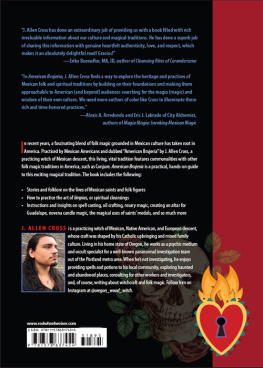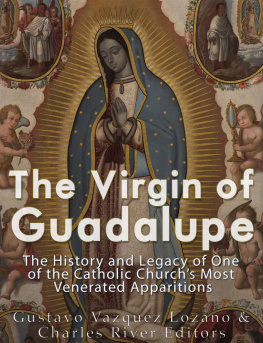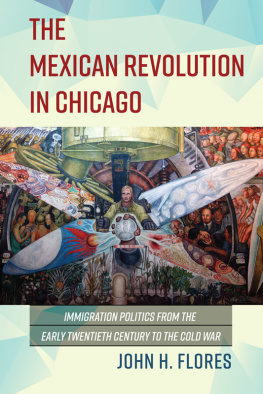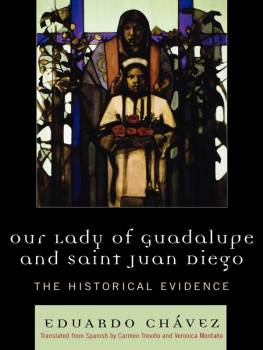Thank you for buying this ebook, published by NYU Press.
Sign up for our e-newsletters to receive information about forthcoming books, special discounts, and more!
Sign Up!
About NYU Press
A publisher of original scholarship since its founding in 1916, New York University Press Produces more than 100 new books each year, with a backlist of 3,000 titles in print. Working across the humanities and social sciences, NYU Press has award-winning lists in sociology, law, cultural and American studies, religion, American history, anthropology, politics, criminology, media and communication, literary studies, and psychology.
Guadalupe in New York
NEW YORK UNIVERSITY PRESS
New York and London
www.nyupress.org
2010 by New York University
All rights reserved
Library of Congress Cataloging-in-Publication Data
Glvez, Alyshia.
Guadalupe in New York : devotion and the struggle for citizenship rights among Mexican immigrants / Alyshia Glvez.
p. cm.
Includes bibliographical references and index.
ISBN-13: 9780814732144 (cloth : alk. paper)
ISBN-10: 0814732143 (cloth : alk. paper)
ISBN-13: 9780814732151 (pbk. : alk. paper)
ISBN-10: 0814732151 (pbk. : alk. paper)
1. Mexican AmericansNew YorkNew YorkReligion. 2. Mary, Blessed Virgin, SaintDevotion toNew YorkNew York. 3. Guadalupe, Our Lady of. 4. CitizenshipUnited States. 5. United StatesEmigration and immigration. 6. Civil rightsUnited States. 7. Emigration and immigrationReligious aspectsChristianity. I. Title.
BR563.M49G35 2009
305.8687207471dc22 2009026863
New York University Press books are printed on acid-free paper, and their binding materials are chosen for strength and durability. We strive to use environmentally responsible suppliers and materials to the greatest extent possible in publishing our books.
Manufactured in the United States of America
c 10 9 8 7 6 5 4 3 2 1
p 10 9 8 7 6 5 4 3 2 1
Arrival of La Antorcha Guadalupana, outside
Saint Patricks Cathedral, December 12, 2002
Acknowledgments
This book would not exist without the significant contributions of the research participants, colleagues, mentors, friends, and family who cared enough about the project and about me to ensure its existence. In spite of their efforts, the errors and faults of this book that undoubtedly remain are mine alone.
It is impossible not to think of those who have passed away in the period encompassed by the research and writing of this bookeach loss is a sad marker in the trajectory of the project and my life: Jocelyn Sols, William Roseberry, Foster Buckner, Jr., Lowell Livezey, and Sarah Hannah. I also cannot but mention the new lives who burst onto the scene and inevitably put everything into perspective, most especially my sons Lzaro and Elas, as well as their cousins and my friends children.
For making this book possible, I thank the organizations within which and individuals with whom I conducted this research. While they did not always fling their doors open for me, their eventual openness, respect, and enthusiasm about my project were all the more precious for having been gradually earned. Too many people to name took time out of their busy lives to orient me, allow me to tag along with them, and answer my pesky questions. Among those who went out of their way to be helpful, I must make special mention of Mara Ziga, Manuela Fuentes, Father John Grange, Joel Magalln, Luz Mara Magaa, Esperanza Morales, Teresa Garca, and Jocelyn Sols. Jocelyns overbrimming enthusiasm was matched only by her powerful intellect, making her untimely loss all the more tragic and a particularly sad punctuation mark in the time period and community this book describes.
Like a fairy godmother, Judy Hellman dropped into town at just the right moments over the course of several years. She demonstrated enthusiasm for the project before even I was sure what it was about and then gave me wise counsel on its development all the way to press; I am very thankful to her. Diana Taylor, Faye Ginsburg, and Thomas Abercrombie have provided constant support, guidance, and countless opportunities for learning and growth (not to mention material sustenance!) from the very beginning. Courses with and mentorship by Linda Green at Columbia University and Rolf Foerster at La Universidad de Chile inspired me to become an anthropologist. William Roseberry deeply impacted my perspective on the discipline, as well as its relationship to history, and moved me by generously serving as reader on my masters thesis in the last months of his life. Bambi Schieffelin, Robert Smith, Lok Siu, and Joel Magalln helped me plant the initial germ of an idea that would become this book. Renato Rosaldo arrived at New York University as I was leaving, but I will be forever grateful for the incredible generosity he showed me and his eagerness about this project. I am particularly indebted to him for his attention to this as a piece of writing, not just writing up. I am thankful to Fred Myers for introducing me to Jennifer Hammer at New York University Press, and to Jennifer for her passion for the project and meticulous attention to its realization in its current form. I also thank the no longer anonymous reviewers, Miguel Daz-Barriga and Joseph Palacios, whose constructive advice made revision far less agonizing than it might have been.
Material support for the research contained herein came from the Social Science Research Councils Program on Philanthropy and the Nonprofit Sector, the Wenner-Gren Foundation, and the National Science Foundation. The SSRC in particular provided support in the form of multiple grants as well as the opportunity for fellowship with other scholars at important junctures. During the writing and revision of this book, I had the good fortune of holding a two-year teaching fellowship at New York Universitys Center for Latin American and Caribbean Studies (2005 2007). There, I was exceedingly fortunate to co-teach with George Ydice and benefit from his bottomless knowledge. Also at CLACS, I was fortunate to work with, know, and receive lots of help from Maritza Coln, Patricia Oscategui, Ana Mara Ochoa, Carolina Fermn, and Thomas Abercrombie. Masters students and graduate assistants at New York University who not only suffered my obsessions in my courses but did everything from hunt down library books to debate transnationalism and immigrant rights with me are Eva Blom Raison, Eileen OConnor, and Catherine Reiland. Catherine in particular has been a joy to work with on this and a half-dozen other projects, even reading the entire manuscript for me at a crucial moment.
During the writing of this book, I benefited from invaluable opportunities to present portions of this book and receive extremely helpful suggestions from extraordinary colleagues. These opportunities included a faculty seminar in the City University of New Yorks Center for the Humanities on the Sacred and the Secular funded by the Mellon Foundation (20082009), working groups and many activities at New York Universitys Center for Religion and Media and Hemispheric Institute of Performance and Politics, as well as a University Seminar on Religion in New York City at Columbia University. Other helpful opportunities for feedback included lectures I was invited to deliver at Bard College, Fordham University, and la Universidad Autnoma de la Ciudad de Mxico.









